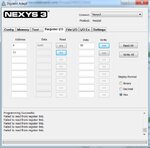makanaky
Advanced Member level 4
Hi,
I wrote a software that writes data to the FPGA register, and read the processing results. I found that for repetitive read/write, the software fails to read registers anymore (the DpcPutReg function returns -1)
I also tried to make this using Adept software, after some (10~30) reads/writes, I cannot read/write registers anymore and I need to reprogram the bit file as attached. Can you please support me with this or tell me what's wrong ?
Thanks
I wrote a software that writes data to the FPGA register, and read the processing results. I found that for repetitive read/write, the software fails to read registers anymore (the DpcPutReg function returns -1)
I also tried to make this using Adept software, after some (10~30) reads/writes, I cannot read/write registers anymore and I need to reprogram the bit file as attached. Can you please support me with this or tell me what's wrong ?
Thanks
